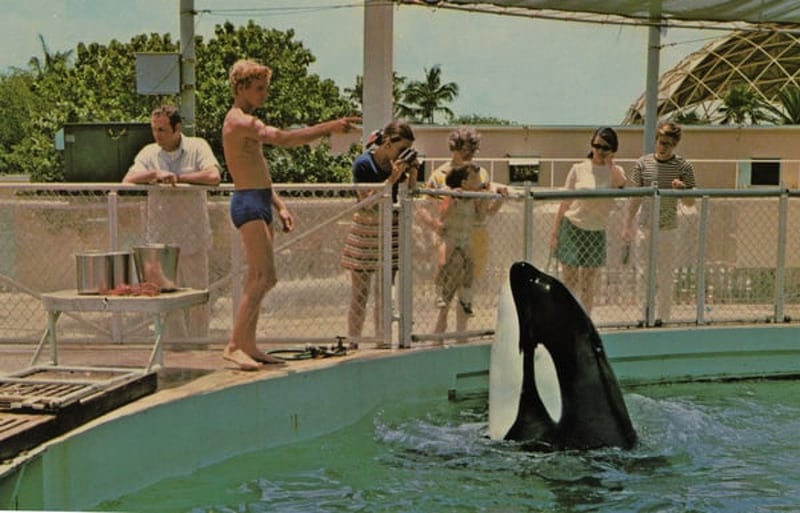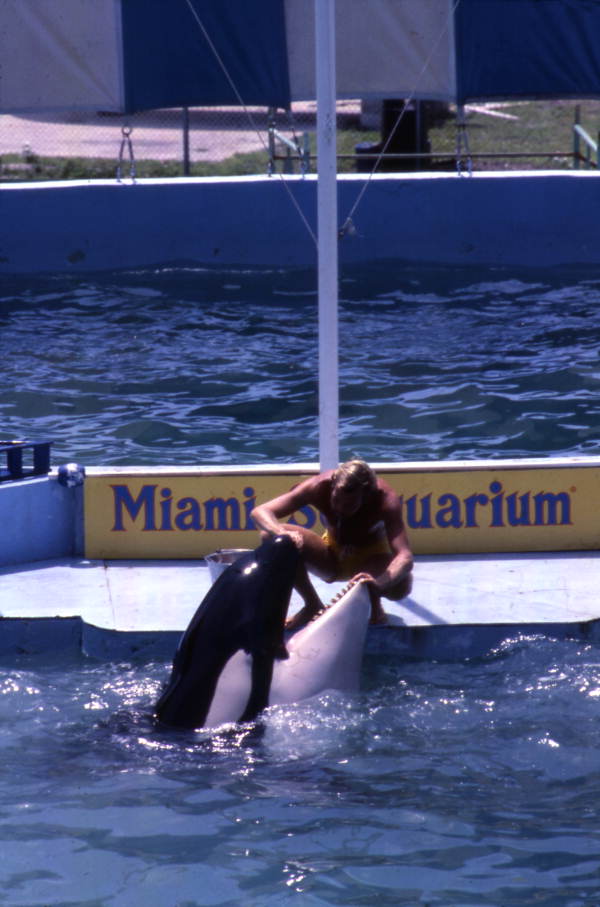
Hugo lived in the smallest orca tank in North America with Tokitae (Lolita) at the Miami Seaquarium until his death on March 4, 1980.
Captured from the waters of the Vaughan Bay off the coast of Washington in February 1968 at three years old, Hugo was sent to the Miami Seaquarium and held in a tiny pool called the “Celebrity Pool.”
After two years, the “Whale Bowl,” which was eventually dubbed the smallest orca tank in North America, became his permanent home. This tank was a mere 80 feet by 35 feet (24 meters by 11 meters) and only 20 feet (6 meters) deep, which he shared with Tokitae (Lolita), who had also been captured from the wild in 1970, approximately two years after Hugo.
Ric O’Barry, a former animal trainer turned animal activist, mentioned in his book, Behind the Dolphin Smile, that the Whale Bowl was so small Hugo’s head was out of the water and his tail was touching the concrete bottom during feeding times. Similarly, Tokitae’s (Lolita’s) body was about as long as the Whale Bowl was deep, so neither orca could dive deep and swim the way they would in the wild.
Hugo entertained tourists in the Whale Bowl alongside Tokitae (Lolita) for 12 years, where they were forced to perform circus-style tricks for food. Tokitae (Lolita) performed in the same tiny tank for food until 2022, when her health started declining.
Similarly to other captive orcas, like Tilikum, the “star” of the documentary Blackfish, Hugo regularly attacked his trainers by biting and bumping into them. The Administrative Director, Anthony G. Toran, stated Hugo “made what appeared to be direct efforts to harm the human performers.”

Other aggressive incidents with Hugo include:
- Trainer Chris Christiansen needed seven stitches to his cheeks after placing his head within Hugo’s jaws
- Trainer Chip Kirk was left with a permanent scar on his arm after being jostled in the pool by Hugo
- Jeff Pulaski had his wetsuit torn from him by both Hugo and Lolita
Orcas suffer immensely in captivity—both physically and psychologically—often becoming aggressive and frustrated due to boredom. From stereotypical behaviors like swimming in circles and floating lifelessly (known as “logging”) to self-harm, killer whales have been filmed repeatedly suffering due to their captivity.
During his lifetime, Hugo self-harmed regularly. He was known to bash his head into the side of his tank, even once breaking a plastic viewing bubble. Hugo also sliced off the tip of his rostrum, leaving a skin flap of at least 3 inches dangling from his body, which had to be surgically reattached.
According to former SeaWorld trainers, it’s common for captive orcas to self-harm, grinding their teeth down on the metal bars of their tanks exposing the nerves or chewing concrete out of boredom. They would regularly witness orcas “jaw-popping,” a sign of aggression, and raking each other.
In recent years, videos of Morgan—a killer whale at Loro Parque Spain—and Kiska, an orca who lived at MarineLand in Canada—were both filmed ramming into the sides of their tank in apparent self-harming behaviors.
On March 4, 1980, Hugo suffered a brain aneurysm, likely due to the repeated bashing of his head against the walls and bars in his tank. He was just 15 years old when he died, which is drastically young compared to his wild counterparts who have been known to live into their late 90s and early 100s.
After Hugo’s death, his body was lifted from his tank by a crane, with a photograph showing his flippers limp in the air. It’s unknown what happened to Hugo’s body, but it’s likely the Miami Seaquarium disposed of him in a landfill.
From March 4, 1980, until her death on August 18, 2023, Tokitae (Lolita) never saw another killer whale again. Instead, she shared the Whale Bowl with Pacific white-sided dolphins, Elelo, Bimini, Catalina, and Li’i, among others.
Hugo and Tokitae (Lolita) suffered immensely at Miami Seaquarium during their lives, but other animals continue to suffer at the dilapidated venue.
Please take action now, in memory of Hugo, to shut down Miami Seaquarium. Forever.
Images: State Archives of Florida